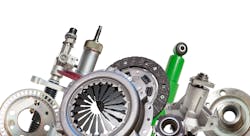EXCLUSIVE: Just-in-time risk management defined by leading strategy firm
Risk management in response to the rippling supply lanes across the Pacific and Atlantic oceans is keeping the strategists busy at Roland Berger. Global just-in-time product ordering remains fragile, explains Neury Freitas, senior partner at Roland Berger. More concerningly, the Russian invasion in Ukraine is compounding the two-year-old coronavirus shock to the supply chain. The long-term outlook from these externalities may force automotive aftermarket businesses to rethink these risks to everyday operations. Freitas fields several open-ended questions on what it means to stay resilient.
Product delays, delivery shortages and record-high inflation continue to test manufacturers and suppliers. What are you seeing?
The entire automotive aftermarket supply chain has been under pressure for more than two years. Companies with a higher reliance on products coming from Asia are having a hard time remaining competitive —given the increase in freight costs— and maintaining minimally acceptable fill rate service levels. We've seen companies lose contracts with the big distributors and retailers due to the suppliers not improving their service levels at the same rate as other competitors.
Gas prices in the U.S. peaked at $4, the highest since 2008, partly because of Russia's invasion of Ukraine. The global energy market is upended, so what does this disruption mean for the automotive aftermarket?
In the short term, changes in gas prices tend to have a negligible impact on general miles driven. However, if prices remain high for a long time, we should expect to see people driving less. In this scenario, we should expect a proportional reduction in miles traveled on a volume basis.
But for the mid-to-long term, we expect this will continue to drive companies to change their manufacturing footprint and the mix of countries they use to produce or source their products.
Given these externalities, do you believe that the supply chain will normalize any time soon, or do you expect the industry to adapt to more changes?
The supply chain will normalize but during the next 18 to 24 months. Given the backlog from COVID, port and trucking labor shortages, the chip shortage, and now the war in Ukraine, we expect that the supply chain will remain in flux. Companies will have to continue to work around these constraints and have creative solutions to succeed.
What's the leading driver of innovation in supply chain and logistics movements?
Distributors and retailers are increasingly demanding better visibility and flexibility in their inbound supply chains to proactively respond to regional or route-based ports ranging from the Suez Canal to the Port of Los Angeles.
What lessons in the ripple effects of disruption are Roland Berger taking away?
The ripple or "bullwhip" effect isn't new nor the first time. It certainly won't be the last event of this kind happening. However, as companies become more comfortable sharing information with customers and suppliers, there's a good chance of flattening the magnitude of future ripple effects. Better sharing across the supply chain, including key stakeholders such as warehousing and logistics and expanded visibility into the tiered supply chains will enhance visibility and planning response times to future ripples. Also, shortening supply chains through localization will reduce direct and indirect failure points.
Let's discuss digitalization and technologies; which ones will impact supply chain operations?
Regarding solution sets, increased use of supply chain control towers and risk management software will enhance the suppliers' opportunities to address future shocks proactively. At the same time, increased penetration of battery electric vehicles and software-enablement of vehicles are driving critical usage of constrained materials like semiconductor chips, rare earth elements, cobalt, lithium and the like through complex supply chains.
Overall, which emerging trends in the U.S. vehicle park that should managers consider?
The U.S. vehicle parc is in a slow but constant transformation. The increased sales of SUVs and CUVs at the detriment of sedans are being strongly felt now. The increase in EV sales that we're seeing now will continue to penetrate the market. It will have a meaningful 10 percent share approximately by 2030.
How is eCommerce changing the movement of goods?
It's important to note that although the growth has accelerated, the automotive aftermarket is still far behind other industries in terms of eCommerce sales and service contracts. Suppliers have been expanding their ability to drop-ship in parcel quantities directly to consumers (D2C), based on expanded D2C channel development or on behalf of their traditional customers' online sales operations. Pure eCommerce players and new entrants have continued to expand their presence in the "do-it-yourself" marketplace. They continue to innovate and grow into the "do-it-for-me" space, offering customers the opportunity to select the part or service in advance and have it shipped to their shop of choice for installation.
Which emerging technologies do you believe will benefit inventory management?
Increased vehicle connectivity from a demand standpoint will provide enhanced visibility into vehicle health, including advanced notification of failure or loss. Increased online-to-offline business models and service scheduling minimize needs for point-of-purchase inventory redundancy. Supply chain control towers will provide better visibility and trust in inventory availability. Virtual inventory methods will provide opportunities to reduce local inventory overlap. Improving supplier fulfillment capabilities to support customer channel requirements will allow increased leverage of supplier inventory for lower frequency and larger footprint items.



